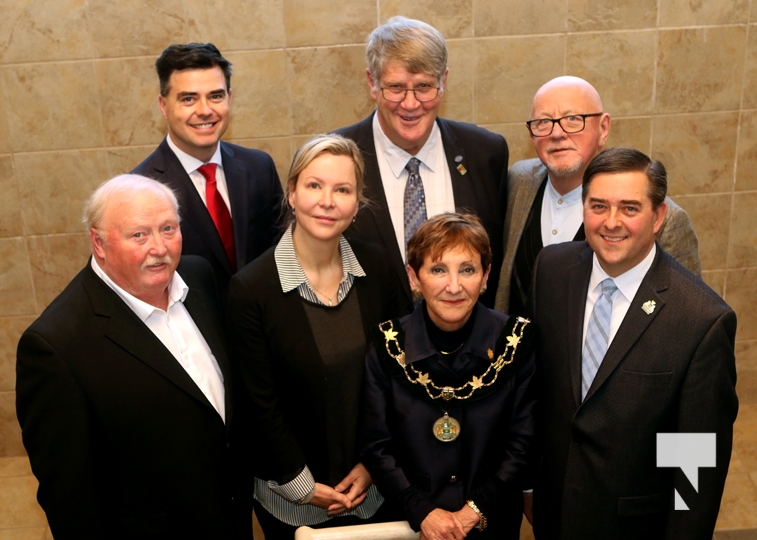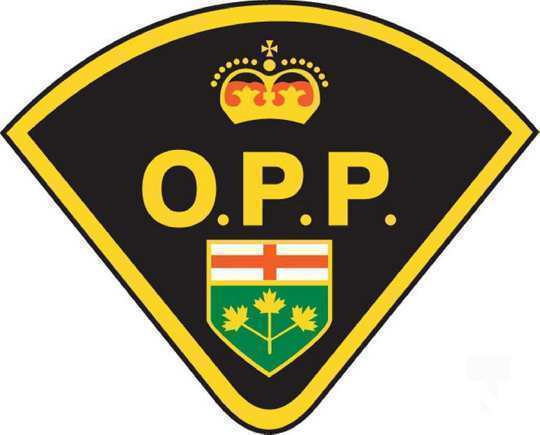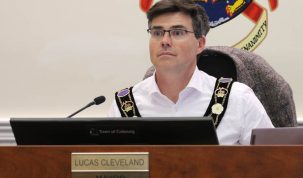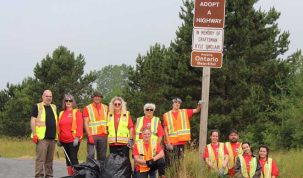By Cecilia Nasmith/Today’s Northumberland
Port Hope will lead the way in finding some kind of viable alternative to the unsanctioned overdose-prevention tent making the rounds in Cobourg.
At Wednesday’s meeting of Northumberland County council, following a presentation on the harm-reduction efforts of the Haliburton Kawartha Pine Ridge District Health Unit, Mayor Olena Hankivsky pledged to take an appeal back to her council to foster the first steps toward such an alternative with offers of support in whatever form is needed, from efforts to organize those vital initial consultations to offers of a venue for such gatherings.
It’s a first step on a journey of many miles, as set out by Medical Officer of Health Dr. Natalie Bocking in her presentation.
Both Ontario and Northumberland County statistics show that the problem clearly existed but, around 2016, began taking a sharp upward climb. Peaks in such things as opioid toxicity deaths and emergency department visits for suspected drug overdoses were reached during the pandemic and are now beginning a decline – but as yet, not nearly back to pre-2016 levels.
Their website now includes a opioid-overdose data dashboard with regional information and statistics. But one alarming fact is that, of all Ontario health units, HKPR ranks in the top 10 for opioid toxicity mortality rate.
“Our region is certainly impacted,” Dr. Bocking said.
“We are a smaller rural region, but I don’t think we can say this is the rest of the province’s problem and not ours.”
Features that have exacerbated the current crisis include a drug supply that is more likely to be toxic – of all the opioid toxicity deaths in Ontario in 2022, 84% were caused by fentanyl.
The COVID-19 pandemic isolated people who might otherwise have used with friends (in other words, someone to make sure they are okay and, if necessary, administer Naloxone) – not to mention bringing about barriers that suddenly hampered access to the health-care system.
The HKPR response falls under two broad categories – prevention and harm reduction.
Prevention involves so-called upstream work like parenting and school supports, health promotion and advocacy on issues of such social determinants as poverty.
Harm-reduction efforts include such consumption services as needle and syringe programs, Naloxone programs and drug testing.
They also work to separate the true from the false regarding harm-reduction programs.
For example, it is true that they result in fewer overdose deaths, decreased spread of blood-borne infections like HIV, less strain on the health-care system, less drug paraphernalia left around for members of the public to find and increased participation in treatment options.
They do not entice people into becoming users or lead to increased robbery and drug-related loitering and criminal offences in the surrounding communities.
A sanctioned site has several requirements – a community-needs and feasibility assessment, demonstrated cross-sector collaboration and community support, a location approved by the host municipality, a Federal exemption and some form of funding (be it provincial or municipal).
Only 24 such sites operate in Ontario, all of them in more densely populated municipalities than Northumberland. The closest one is probably in Peterborough, opening about a year ago. Perhaps, for Northumberland, the answer might lie in another direction, such as a mobile service or one that rotates sites.
Though there is not such a site in Northumberland, the health unit is mandated to work with community partners to address the harmful use of substances, support community coalitions that also do this work, support peer-based approaches that involve people with lived experience, provide harm-reduction materials and issue opioid-overdose alerts when warranted.
“It’s a complex problem, requiring collaboration and mutual approaches. It will take time to solve,” Dr. Bocking said.
“We know there’s not an easy, quick solution to the challenges that Northumberland County is facing, maybe Cobourg more specifically.”
Hankivsky pointed out that the crisis was years in the making and wondered why so little was done as, it really began taking shape seven years ago.
Dr. Bocking said she was not trying to use the pandemic as an excuse, but its effect was undeniable.
“The pandemic certainly redirected public health efforts and made many avenues much more challenging to access – meetings with community partners, school presentations.” she said.
It also made it difficult for potential collaborations with community organizations that are, so to speak, on the ground and in touch with vulnerable populations and already possessing relationships with the people most in need of these services.
“There’s always more that can be done, certainly more the health unit needs to do – but more that we all need to do,” she said.
“There’s only so far we can move forward on our own, and we require on-going collaboration and support across all the sectors to be able to move that forward.”
Dr. Bocking cited difficulties, for example, that the health unit has experienced with some municipalities in establishing safe needle-disposal sites.
“The first approach is to bring all the right people to the table and have a common agreement about the current challenges and where we want to go.”
Councillor Lucas Cleveland agreed it is a crisis situation, but pointed out that all county councillors are dealing with multiple crises – such as the very acute housing crisis.
“We are all working really hard to build housing as quickly as we can. But they don’t decide to abandon the rules and processes like the building code,” Cleveland pointed out.
“Regarding the set-up of an unsanctioned overdose-prevention site, this county, as well as Cobourg, has come out very strongly against not following procedures and policies.”
Dr. Bocking noted that some municipalities are working with community groups to find ways to work within existing policies, sometimes changing existing policies to work toward preventing overdose deaths and keep people safe.
“No matter what happens, as long as we prevent deaths, that’s acceptable, no matter what rules are broken? No matter what policies are broken? No matter what happens in the community?” Cleveland challenged.
Dr. Bocking suggested that perhaps these might be the people who should be included in the conversation.
Warden Mandy Martin pointed out the very strong proactive work the health unit is doing, and wondered if Cleveland’s tone might suggest he wasn’t aware of that.
“I am concerned about the tone of that question and the tone I am hearing from many councillors in the room,” Dr. Bocking agreed.
“We work very closely with municipalities every single day, and we have for many years. When we talk about the future, when we talk about collaboration, we are talking about all of us moving together. This is not about placing blame. We all have a role to play, and it’s not about saying we should have done more before. In the end, we are faced with the challenge we have right now, and we have opportunities before us.”
Hankivsky relented and expressed appreciation for the health unit’s work in harm reduction, but insisted attention must be paid to the 20 Northumberland opioid toxicity deaths in 2021. If there is not to be a sanctioned site, she wondered, what option is there.
“What do I say to my community? What do I say to affected people? What do I say to families who need help?” she wondered.
“We start by saying we care,” Dr. Bocking said.
“We value all members of our community, and we are here to figure out what it takes to move forward. There will be bumps in that road, but that does not mean we are not going to find a way.”
The first step is determining the need in relation to what supports and resources exist. This is where the assessment Hankivsky mentioned will come in, and there will be a lot of pieces. It must include people with lived or living experiences. It must have the support of local councils, as well as letters of support from businesses and members of the community. And the vision must be a service that will be designed for the benefit of those who need it.
“Are some of those groups ones that have clearly come out and said without question they are against working with those us, who are impatient, who have come out very specifically to say they are forming a resistance and are unwavering, no matter what? It’s their official position saying we have come out specifically against those who are following the rules and don’t care what they say,” Cleveland demanded to know.
Dr. Bocking said that the health unit works with many different partners, many different organizations with many different associations within the community – including, critically, the individuals who need certain services. They also strive to be respectful of each group’s needs.
“So the health unit has no issues working with organizations that have blatant disregard for the norm?” Cleveland asked.
Dr. Bocking repeated her answer.
“Again, I….” Cleveland began.
“You’re done,” Martin interceded.
To which Cleveland replied, “Yes, ma’am.”
“Please know we are in this for the long haul,” Martin told the health unit representatives.
“Certainly we do want to work with you. It’ a real crisis.”
The matter came in for further discussion later in the agenda, as council considered a motion calling on local responses to the opioid crisis to be incorporated into the continuum of care being established by the province as part of its Roadmap to Wellness “to ensure safe, connected services that lead to improved health outcomes.”
The motion also included the line that county council “does not endorse the operation of any unsanctioned overdose-prevention sites in Northumberland County.”
Hankivsky made the motion to add a further paragraph. As approved by council, it added the resolution “that county council direct staff to collaborate and support the Haliburton Kawartha Pine Ridge District Health Unit on a community-needs and feasibility assessment for a sanctioned consumption site in Northumberland County, including appropriate and immediate responses and long-term solutions for consumption services that comply with local, provincial and Federal laws.”
“I do think this motion does speak to following processes as municipal council representatives and as county council, we expect to follow,” Hankivsky said.
Councillor Brian Ostrander asked to add the wording about legal compliance.
“Because there are people in our community right now who believe they have an appropriate solution, but that solution does not comply with local bylaws or the Criminal Code,” Ostrander pointed out.
“I would rather it be said and on the record,” Martin agreed.
“Sometimes the assumption is not enough”
Hankivsky stated her wish that the process not set up a sanctioned consumption site as the only goal, and that other more-immediate measures might be ascertained and executed.
Martin agreed with this as well.
“I don’t think that a sanctioned consumption site is necessarily the answer at all,” she stated.
“To restrict ourselves to that is just setting us up for failure. We will not meet the criteria for funding, as we perceive it, for this area, so I think there are other approaches.”
“There may be things we haven’t even thought about, that we don’t know because we haven’t had the needs assessment, we haven’t had the proper consultation,” Hankivsky said.
As long as it’s all done legally, Ostrander reiterated.
Cleveland made another point, recounting his experiences (during his decade in the oil-and-gas industry) of losing friends to overdoses who died in his arms on oil rigs.
“I speak from experience. I speak with compassion and with empathy,” Cleveland said.
“My concern today, and one that may come across in the wrong tone, is that we are allowing individuals to push what they want to happen without following the proper procedures and/or processes by which we as elected officials have sworn to follow.”
Cleveland decried “a lack of compassion and understanding among some of these individuals of the position we are in as elected officials.”
He warned council against “setting a precedent about if people in our community don’t like the way things are going, they will do what they like and we will respond to their needs.”
Cleveland also reminded councillors that everyone is entitled to his or her personal autonomy. Harm-reduction measures do exist, counselling services are available, many avenues of assistance can be accessed even now, he said – but in the end, each person chooses whether to take advantage of a helping hand or to continue on the risky path he or she has chosen.























